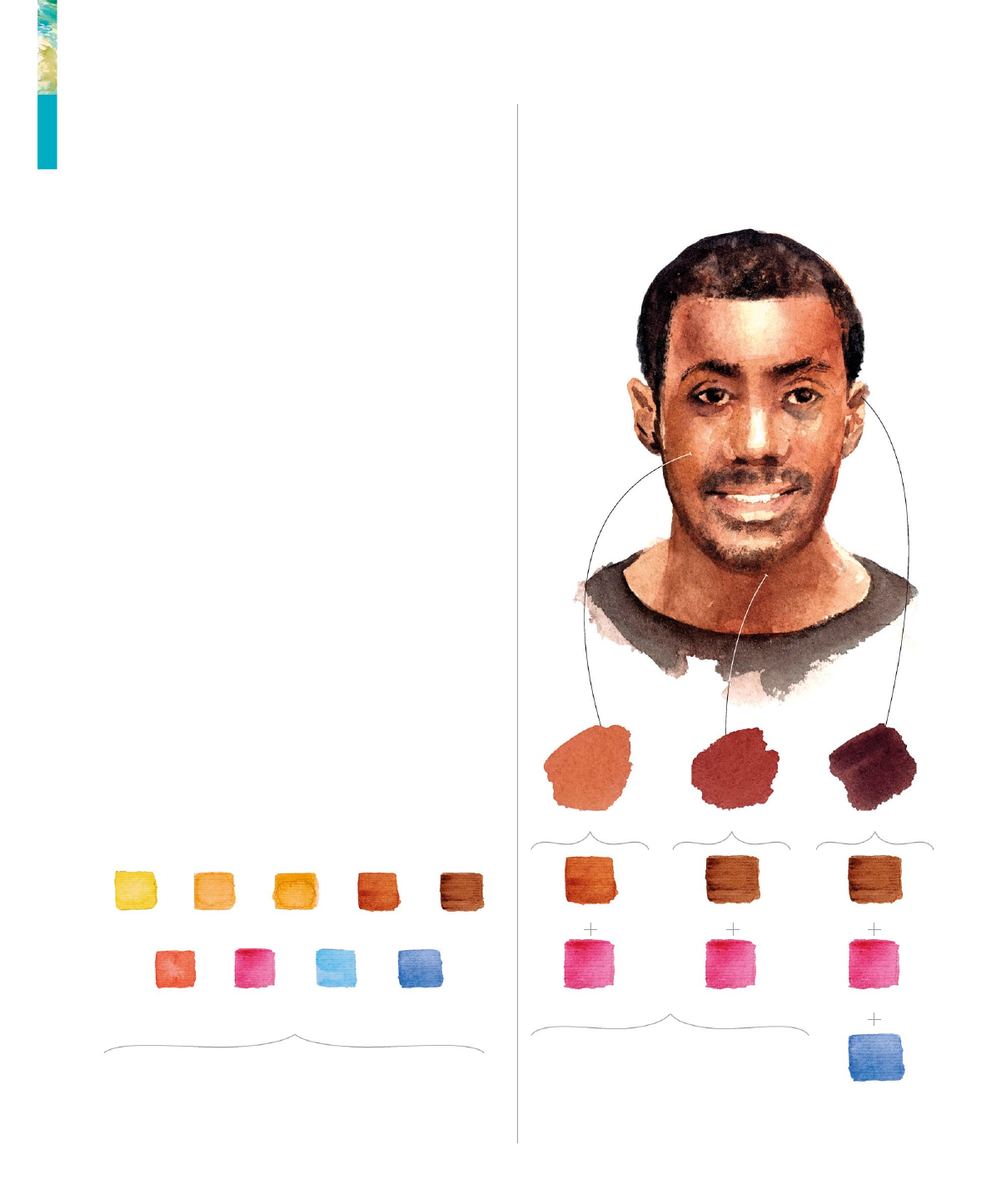
220 Portraits, figures, and animals | SUBJECTS
Skin tones
PAINTING THE COLORS IN SKIN
Realistic skin tones are best painted with
just a few basic colors, since this results in
tones that harmonize with each other and
provide a natural appearance. All skin tones,
from the lightest to the darkest, can be
painted with a limited palette of just three
colors, with reserved paper providing white
for the highlights.
Dark skin tones
Dark skin uses burnt sienna in the high tone. Mixing
it with cool crimson prevents the skin tone being too
orange. Burnt umber in the mid tone gives a warm
brown which can make a mauve in darker mid tones.
Light and shade
Look for the high, mid, and dark tones in your subject’s
skin, which depend on the direction and strength of
the light source. When close to light, the skin may look
paler, cooler, or yellower. Using a cool green or purple
mix is an effective way to depict shadows, as they will
complement the warm reds and yellows in the skin.
Flesh tones
Using a basic palette will give you a good starting
point for mixing skin tones. Earth colors such as sienna,
umber, and ocher often provide a good foundation for
esh tones; you can mix them with primary colors to
create warmer or cooler hues according to the high,
mid, and dark tones you have identied.
Palette for dark skin
Use burnt sienna with crimson for the high
tones, substituting burnt umber for the sienna in
the mid tones. For very dark skin, make strong
mixes and add ultramarine to cool the color a
little so that the crimson does not dominate.
High tones
Burnt sienna
Yellow
ocher
Cerulean
blue
Cadmium
yellow
Raw
sienna
Burnt
sienna
Cadmium
red
Alizarin
crimson
Ultramarine
Burnt
umber
Burnt umber Burnt umber
Alizarin crimson Alizarin crimson
Ultramarine
Alizarin crimson
Mid tones Dark tones
Limited palette
Mixing skin tones from a limited palette of colors will help unify
your painting. Choosing a warm and cool version of each primary
color will ensure that you can create a wide variety of convincing
skin tones, no matter the complexion of the subject.
US_220-223_Portrait_2_Skintone.indd 220 02/04/2020 3:35pm

221 Skin tones
Light skin tones
Light skin can be painted from pink through to yellow
tones by varying the balance of alizarin crimson to
yellow ocher in the rst mix for the high tone. Use
darker tones of the mixes for shadowed areas.
Palette for light skin
Use the basic colors of
yellow ocher and burnt
umber, adding touches
of crimson or ultramarine
for warm or cool areas.
High tones
Yellow ocher Yellow ocher Burnt umber
Alizarin crimsonAlizarin crimson Alizarin crimson
Ultramarine Ultramarine Ultramarine
Alizarin crimsonAlizarin crimson
Mid tones Dark tones
Olive skin tones
Olive skin has raw sienna instead of burnt sienna in
the rst mix for the high tone. Raw sienna is a yellower
color, which is also used in the mid tone to keep the
olive complexion from looking too brown.
Palette for olive skin
Lay washes for the overall skin color and tone
then use darker tones for shadow areas. For
olive skin, use only subtle variations of color
and tone to give a convincing effect. Allow
washes to dry then build up gradually.
High tones
Raw sienna Raw sienna Burnt umber
Burnt sienna
Mid tones Dark tones
US_220-223_Portrait_2_Skintone.indd 221 02/04/2020 3:35pm

222 Portraits, figures, and animals | SUBJECTS
A relaxed pose
PUTTING IT INTO PRACTICE
Portraits rely on a slow build up of washes, because it is easy
to add extra paint but undesirable to lift out unwanted edges
and marks, since it leaves the skin looking too shiny. Secondary
colors are best mixed rather than using manufactured colors.
1
Laying a base color
Paint a mix of crimson and ocher over the
face, leaving reserved highlights on the top
and side of the head and the beard area. Dilute
the wash where the mustache will be. When
this wash is dry, use the color again to darken
some areas, in particular around the eye
sockets, sides of the nose, and under the chin.
2
Modeling the head
Mix a wash of crimson, ocher, and cerulean
with which to create a three-dimensional tonal
image, paying attention to the bone structure
of the head. Form the eye sockets, dene the
nose, and shape the cheek bones. When this is
dry, use the same wash a second time to
darken the features.
No. 12, no. 8, and no. 4 soft-hair round brushes
Craft knife or razor blade
15 x 12 in (38 x 30 cm) cold press linen
140 lb (300 gsm) watercolor paper
You will need
Alizarin crimson
Cadmium yellow
Cadmium red
Yellow ocher
Ultramarine
Burnt sienna
Burnt umber
Cerulean blue
First wash
color
Second
wash color
Cerulean blue
and alizarin
crimson create a
cool lilac shadow
Yellow
ocher
Yellow
ocher
Cerulean
blue
Alizarin
crimson
Alizarin
crimson
US_220-223_Portrait_2_Skintone.indd 222 02/04/2020 3:35pm

223 Skin tones
3
Intensify colors
Using ocher, red, cerulean,
and crimson, paint the brighter
colors of the skin and clothing.
Cadmium red mixed with ocher
down the center of the nose
brings it forward. Dry brush a
mix of ocher and cerulean to
suggest beard stubble. Drag
a mix of cerulean, ocher, and
crimson for the eyebrows,
beard, and mustache.
4
Darkest tones
Make a mix of ultramarine,
crimson, and umber to create a
soft black for small details. Use
this mix for all the features,
varying it to make brown,
mauve, and green darks for a
lively portrait. Dry brush the
mix over the beard in a broken
stroke to give the impression
of whiskers.
5
Lift out details
Once the painting is completely dry,
use a sharp blade to lift out just a few
of the hairs of the beard that were not
possible to reserve.
Soft black
color
Alizarin
crimson
UltramarineBurnt
umber
US_220-223_Portrait_2_Skintone.indd 223 02/04/2020 3:35pm
..................Content has been hidden....................
You can't read the all page of ebook, please click here login for view all page.
